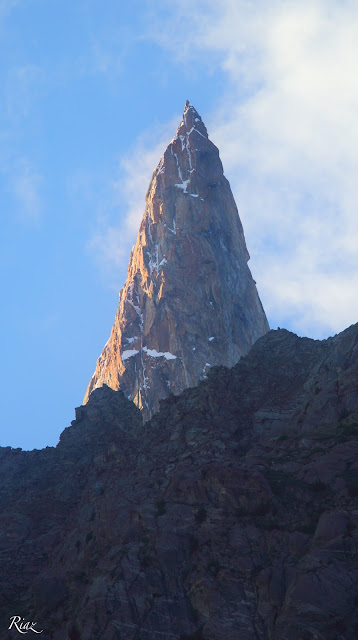Hello everyone, RMK here! After having a wonderful
birding season during the early months of the year, finding summer birds in
Islamabad became difficult due to the heat. So, yours truly, Swabi Birder, decided to undertake a long journey to the see the majestic
mountains of the Northern Territories, with the hope of seeing new species of
birds to add to my Pakistan Birding List.
 |
| Rufous-naped Tit |
 |
| Dark-sided Flycatcher |
This trip to the north was unique in that I was
accompanied by my family and my dog in the same jeep from which I thought I would
photograph birds using it as a hide. Anyhow, I started my trip on Eid Day to
avoid the rush on road to Naran, situated in the Kaghan Valley in the Mansehra
District of the Khyber Pakhtunkhwa. To my surprise even on the Eid Day I found
that all the roads were full of cars. The usual species found along the roadside
were hardly there. Disappointed I drove fast to Gilgit and reached Serena Hotel
in the administrative territory of Gilgit-Baltistan, with a sigh of relief.
 |
| Scaly-bellied Woodpecker |
 |
| Adult Male Common Rosefinch |
I immediately took my camera after check-in and went
to the lawn of this beautiful hotel. In the trees I saw an Indian Golden oriole,
a Shrike sp. and Streaked Laughingthrush but couldn’t take any photographs as
the light quickly diminished. I realised on reaching Gilgit that it might not
be possible to see and photograph that many birds, as the traveling involved in
our trip was too much as per the plan. Furthermore, my dog isn’t very friendly
towards birds; photography from my jeep would be difficult.
 |
| Orange-flanked Bush Robin |
 |
| adult male rock bunting |
I decided next day that I would have to make another
plan to return to the Northern Areas in September when the migration will start
and birds will come down from the heights due to snowfall. For this particular
trip though, I will dedicate this it to my family and my dog.
 |
| Eurasian Treecreeper only found in the extreme north of Pakistan |
 |
| Himalayan Goldfinches, a subspecies of Eurasian Goldfinch known as caniceps |
 |
| Black-billed Magpie another Northern Areas specialty |
Realising the distances involved I decided to take photographs
of the birds I encountered on my way and decided against twitching them. Sitting
in the driving seat for almost six to seven hours every day driving over very
rough surfaces, we visited Naltar,
Hunza, the Khunjerab Pass, Skardu and Shigar Fort on the way back
through the lush green mountains and streams of Deosai Plateau at 14,000 feet
above sea level to Chilas, Naran and back to Islamabad.
I will share with you a few images of the birds and
mountains that I photographed. Our readers may be a little disappointed that I haven’t
many images of the Northern birds. However, I am sure that next time I will get
you some lovely images of the birds from the north of Pakistan. Swabi Birder signing out!
 |
| Golden Marmot |
 |
| Adult Shore Lark (Can't stand Horned Lark!), common on Deosai |
 |
| Adult male Citrine Wagtail |
 |
| Female Citrine Wagtail. This species breeds in good numbers on the Deosai Plateau |
 |
| Male Grey Wagtail |
 |
| Juvenile Grey Wagtail |
 |
| Black Redstart |
From Islbirder:
What an incredible journey and all completed within a jeep! Many times whilst I
lived in Pakistan, I tried to visit Gilgit-Baltistan but so many times the
flight from Islamabad to Skardu or Gilgit was cancelled because of the weather
conditions. I made it, only once, to Skardu and the Shigar Valley and the
birdlife was stunning. The Deosai Plateau was breath-taking both due to the
effects of altitude and the stunningly beautiful scenery. I feel honoured and
extremely privileged to have been allowed to visit that very special place. Swabi Birder is most definitely gripping
me (see earlier posts for birding
terminology) with talk of another trip in September! I very much look
forward to you making that trip but you are coming over here to visit the
BirdFair in August first, aren’t you?
 |
| Leaf Warbler but which one? |
Blyth’s Leaf Warbler is a rare vagrant to Pakistan,
although probably overlooked (or just not seen at all!). Western Crowned
Warbler is the most common of all the leaf warblers that occur in Pakistan but
I believe RMK’s photograph could be that of a Blyth’s Leaf Warbler. I would
suggest only putatively at the moment, as we cannot see the body of the bird in
the image. However, the yellow wash on the cheeks and breast look good as does
the white, not greyish-white of the undersides.























